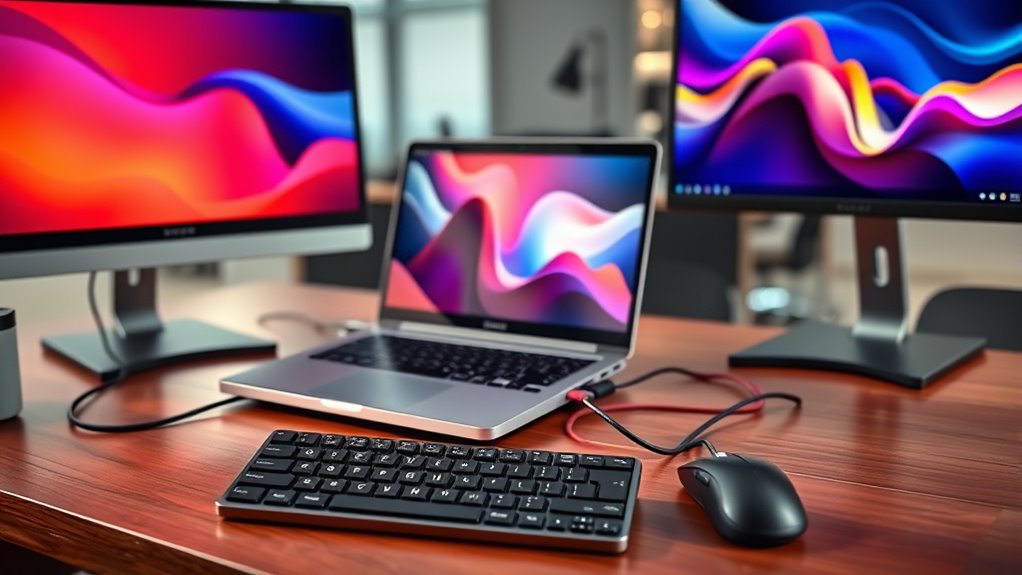To hook up multiple monitors to your laptop, first check your laptop’s display capabilities, including available ports like HDMI or USB-C. Choose compatible monitors and cables based on your needs and resolution preferences. Connect the monitors securely, and then adjust your display settings to arrange them as desired. Make sure to optimize the layout for better productivity. If you want more tips on enhancing your multimonitor experience, there’s plenty more to explore!
Understanding Your Laptop’s Display Capabilities
Before you start connecting multiple monitors to your laptop, it’s essential to understand its display capabilities. Check your laptop specifications to see how many external displays it can support. This varies widely among models, so knowing your limits will help you avoid frustration.
Next, examine the display ports available on your laptop. Common options include HDMI, DisplayPort, and USB-C. Each port type has its own specifications, and some may require adapters to connect to your monitors.
Be mindful of your laptop’s graphics card as well, since it plays a vital role in rendering multiple screens effectively. Understanding these elements empowers you to create a seamless, multi-monitor setup that enhances your productivity and freedom.
Choosing the Right Monitors and Cables
When you’re ready to set up multiple monitors, selecting the right screens and cables is essential for a smooth experience. First, consider the monitor types that suit your needs. You might prefer IPS panels for vibrant colors, or TN panels for fast refresh rates. Think about size, resolution, and aspect ratio as well. Next, check the cable options available for connecting these monitors. HDMI, DisplayPort, and VGA are common choices, but make sure they’re compatible with both your laptop and monitors. You may also need adapters if your laptop has limited ports. By choosing the right monitors and cables, you’ll create a seamless and productive multi-screen workspace that enhances your freedom to work efficiently.
Connecting Your Monitors to the Laptop
As you prepare to connect your monitors to your laptop, make sure you’ve got all the necessary cables and adapters handy. First, identify the monitor types you’re using—whether they’re HDMI, DisplayPort, VGA, or DVI. Next, check your laptop’s available ports to determine which connection methods you’ll use. If your laptop doesn’t have enough ports, consider using a USB to HDMI adapter or a docking station to expand connectivity. Plug each monitor into your laptop using the appropriate cables, ensuring they’re securely connected. If you’re using multiple monitors, connect them in the order you want them to display. Once everything’s plugged in, you’re set to move on to configuring your display settings for an ideal multi-monitor experience!
Configuring Display Settings on Your Laptop
Once you’ve connected your monitors, it’s time to configure your display settings to optimize your workspace. Follow these steps to guarantee everything runs smoothly:
- Adjust Display Resolution: Right-click on your desktop, select ‘Display settings,’ and set each monitor to its recommended resolution for clear visuals.
- Set Refresh Rates: While in the display settings, check the refresh rates of each monitor to guarantee they match or are compatible, providing a smoother experience.
- Arrange Displays: Drag and drop the monitor icons to match their physical layout, making navigation intuitive.
- Choose Primary Monitor: Select the monitor you want as your main screen by ticking the ‘Make this my main display’ option.
These adjustments will create a seamless multi-monitor experience.
Tips for Optimizing Your Multimonitor Setup
To make the most of your multimonitor setup, it’s crucial to implement a few key strategies that enhance productivity and comfort. Start by organizing your screen layout to minimize eye movement and maximize efficiency. Place your primary monitor directly in front of you for easy access, while positioning secondary monitors at slight angles. Don’t forget to adjust the resolution and scaling settings for each screen to guarantee consistency. Consider using software tools that help manage windows and applications across multiple displays, which can greatly boost productivity enhancement. Finally, maintain proper lighting to reduce glare and strain on your eyes, allowing you to work longer and more comfortably. With these tips, you’ll create a workspace that truly empowers your productivity.
Frequently Asked Questions
Can I Use Different Monitor Brands Together?
Yes, you can use different monitor brands together, but monitor compatibility might vary. Brand differences can affect color accuracy and resolution. Just guarantee your laptop’s graphics support the desired configurations for the best experience.
What Resolution Should My Additional Monitors Be?
For a seamless experience, choose additional monitors with an ideal resolution that matches or complements your laptop’s. This guarantees monitor compatibility, creating a vibrant workspace where every detail pops and flows effortlessly across screens.
Will Using Multiple Monitors Drain My Laptop’s Battery Faster?
Yes, using multiple monitors does increase battery consumption. To manage power effectively, adjust your display settings, reduce brightness, and consider using power-saving modes. This can help extend your laptop’s battery life while multitasking.
Can I Extend My Laptop Screen Wirelessly?
Yes, you can extend your laptop screen wirelessly using a wireless display. By enabling screen mirroring, you can project your laptop’s content onto a larger screen, liberating your workspace from cables and enhancing your productivity.
How Do I Switch Between Monitor Configurations Quickly?
You can switch between monitor configurations quickly by using keyboard shortcuts like Windows + P. This opens display settings, letting you choose between duplicating, extending, or using a single display, giving you more freedom in your workspace.

